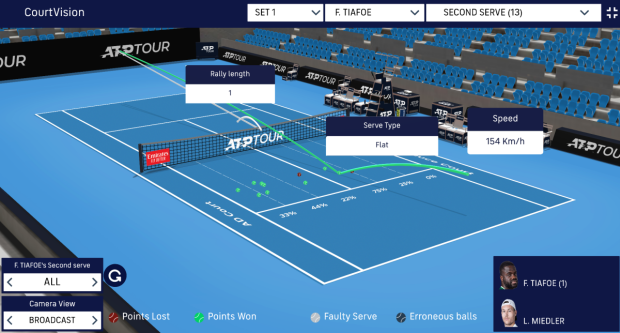Making Top-Level Tennis Video Analysis Affordable and Accessible for Every Player
Making Top-Level Tennis Video Analysis Affordable and Accessible for Every Player
Posted November. 26, 2024 10:57,
Updated November. 26, 2024 10:59
[IT Donga] Innovative technology makes our lives more convenient, but such changes don't happen overnight. Developing such technology is costly, which initially limits access to a select few. Over time, as innovations lead to the creation and adoption of complementary technologies, the benefits gradually become widespread.
Smartphones are a prime example. Initially, they were high-end devices for a niche audience. Today, they are ubiquitous information and communication tools worldwide. A similar pattern can be seen in the replacement of expensive plasma TVs with LCD and LED TVs, the proliferation of drones from military to recreational use, and the evolution of GPS navigation systems from luxury cars to standard smartphone features.
This trend of innovation enabling broader accessibility is now evident in sports data analysis. Traditionally, analyzing sports data required multiple expensive devices installed around a venue, along with substantial time and costs for calibration. As a result, these tools were primarily used by top-tier athletes.
 “Strategizing with tennis data / Source: Envato Elements”
“Strategizing with tennis data / Source: Envato Elements”
How Tennis Data Analysis Is Evolving
With the integration of artificial intelligence and technologies derived from autonomous vehicles and robotics, sports data analysis tools are starting to become as simple and accessible as smartphones, enabling mid-level and amateur athletes to benefit from them effectively.
A clear example of this trend can be seen in tennis. The Hawk-Eye system, a pioneer in tennis data analysis, was introduced in 1999. Using dozens of high-speed cameras, it tracks the ball's trajectory with precision, ensuring accurate line calls during matches. However, its high cost and complex setup meant it was used only in major international tournaments, leaving lower-ranked players and casual users without access.

“Only top-ranked players have access to high-quality, comprehensive match data through expensive systems like Hawk-Eye. / Source: Infosys”
Since then, newer systems like PlaySight, Wingfield, and SwingVision have entered the market, each catering to different user needs. PlaySight’s "Smart Court Pro" system uses 10 cameras to provide multi-angle views and detailed data analysis, making it a valuable tool for large clubs and professional courts, although its high cost may limit broader accessibility. Wingfield offers a user-friendly setup by attaching a kiosk directly to the net, though its pricing may still be a consideration for widespread use across all courts. SwingVision, designed for iOS devices, tracks metrics such as ball trajectory, speed, and spin, providing accessible feedback. However, it faces challenges with device compatibility, battery life, overheating, and a focus on fun-level accuracy rather than professional-grade precision.
ShotAi: Redefining Tennis Data Analysis
The tennis industry is seeking affordable, high-performance, and user-friendly solutions. ShotAi, a tennis data analysis system, leverages technology derived from autonomous vehicles and robots to meet these demands.
Advancements in these fields—such as the development of LiDAR for precise distance measurement, single-board computers (SBCs) for compact multifunctionality, and high-resolution camera systems—have significantly lowered sensor costs and improved AI-powered computer vision and data analysis capabilities.
ShotAi combines these technologies to deliver an innovative solution by having developed compact, easily mountable cameras for tennis court fences. The system incorporates tracking algorithms inspired by autonomous vehicle perception technology, enabling dynamic camera angle adjustments to focus precisely on players and the ball.
The system records data such as player movements, shot patterns, serve and stroke points of contact, and ball trajectories and speeds with accuracy comparable to Hawk-Eye. AI then analyzes this data to help players refine their post-match training and strategies. Additionally, it can monitor player conditions and analyze patterns of both the player and their opponent.
Built for All Conditions and Players
ShotAi’s cameras are designed to withstand rain and harsh sunlight, featuring waterproof and heat-resistant structures. With enhanced battery efficiency, they can record uninterruptedly during extended matches and training sessions.
ShotAi aims to price its system affordably enough for amateurs, junior players, and hobbyists to access. By offering advanced tennis insights, it seeks to elevate the skills and game understanding of all players, helping them take their performance to the next level.
A Vision for Accessible Tennis Innovation
ShotAi CEO Brock Noh shared, “We understand that many junior and aspiring professional players face financial challenges while striving to improve their skills and rankings. Our mission is to provide an accessible solution that allows these players to gain insights and analysis typically reserved for top-tier athletes. With ShotAi, we aim to level the playing field, empowering players at all levels to refine their game and reach their full potential without the financial burden.”
Cha Ju-Kyung (racingcar@itdonga.com)
Smartphones are a prime example. Initially, they were high-end devices for a niche audience. Today, they are ubiquitous information and communication tools worldwide. A similar pattern can be seen in the replacement of expensive plasma TVs with LCD and LED TVs, the proliferation of drones from military to recreational use, and the evolution of GPS navigation systems from luxury cars to standard smartphone features.
This trend of innovation enabling broader accessibility is now evident in sports data analysis. Traditionally, analyzing sports data required multiple expensive devices installed around a venue, along with substantial time and costs for calibration. As a result, these tools were primarily used by top-tier athletes.

How Tennis Data Analysis Is Evolving
With the integration of artificial intelligence and technologies derived from autonomous vehicles and robotics, sports data analysis tools are starting to become as simple and accessible as smartphones, enabling mid-level and amateur athletes to benefit from them effectively.
A clear example of this trend can be seen in tennis. The Hawk-Eye system, a pioneer in tennis data analysis, was introduced in 1999. Using dozens of high-speed cameras, it tracks the ball's trajectory with precision, ensuring accurate line calls during matches. However, its high cost and complex setup meant it was used only in major international tournaments, leaving lower-ranked players and casual users without access.

“Only top-ranked players have access to high-quality, comprehensive match data through expensive systems like Hawk-Eye. / Source: Infosys”
Since then, newer systems like PlaySight, Wingfield, and SwingVision have entered the market, each catering to different user needs. PlaySight’s "Smart Court Pro" system uses 10 cameras to provide multi-angle views and detailed data analysis, making it a valuable tool for large clubs and professional courts, although its high cost may limit broader accessibility. Wingfield offers a user-friendly setup by attaching a kiosk directly to the net, though its pricing may still be a consideration for widespread use across all courts. SwingVision, designed for iOS devices, tracks metrics such as ball trajectory, speed, and spin, providing accessible feedback. However, it faces challenges with device compatibility, battery life, overheating, and a focus on fun-level accuracy rather than professional-grade precision.
ShotAi: Redefining Tennis Data Analysis
The tennis industry is seeking affordable, high-performance, and user-friendly solutions. ShotAi, a tennis data analysis system, leverages technology derived from autonomous vehicles and robots to meet these demands.
Advancements in these fields—such as the development of LiDAR for precise distance measurement, single-board computers (SBCs) for compact multifunctionality, and high-resolution camera systems—have significantly lowered sensor costs and improved AI-powered computer vision and data analysis capabilities.
ShotAi combines these technologies to deliver an innovative solution by having developed compact, easily mountable cameras for tennis court fences. The system incorporates tracking algorithms inspired by autonomous vehicle perception technology, enabling dynamic camera angle adjustments to focus precisely on players and the ball.
The system records data such as player movements, shot patterns, serve and stroke points of contact, and ball trajectories and speeds with accuracy comparable to Hawk-Eye. AI then analyzes this data to help players refine their post-match training and strategies. Additionally, it can monitor player conditions and analyze patterns of both the player and their opponent.
Built for All Conditions and Players
ShotAi’s cameras are designed to withstand rain and harsh sunlight, featuring waterproof and heat-resistant structures. With enhanced battery efficiency, they can record uninterruptedly during extended matches and training sessions.
ShotAi aims to price its system affordably enough for amateurs, junior players, and hobbyists to access. By offering advanced tennis insights, it seeks to elevate the skills and game understanding of all players, helping them take their performance to the next level.
A Vision for Accessible Tennis Innovation
ShotAi CEO Brock Noh shared, “We understand that many junior and aspiring professional players face financial challenges while striving to improve their skills and rankings. Our mission is to provide an accessible solution that allows these players to gain insights and analysis typically reserved for top-tier athletes. With ShotAi, we aim to level the playing field, empowering players at all levels to refine their game and reach their full potential without the financial burden.”
Cha Ju-Kyung (racingcar@itdonga.com)
Headline News
- Lee acquitted of subornation of perjury charges in first trial
- Trump’s second term to pressure S. Korea to join China export controls
- 25 cases of technology theft to overseas caught this year
- Russia warns S. Korea over supplying lethal weapons to Ukraine
- Lee Jae-sung scores header goals in consecutive Bundesliga matches







